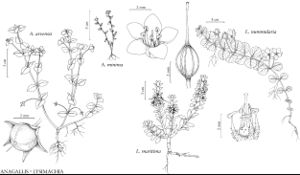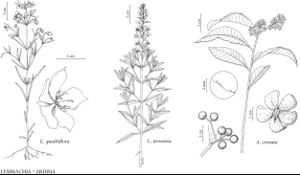Perennial or annual herbs, subshrubs, shrubs, or trees, deciduous (evergreen in Ardisia), often with secretory resin canals appearing as dark dots, streaks, or punctations on vegetative and/or floral parts. Leaves cauline, alternate, opposite, whorled, or pseudowhorled, simple; stipules absent; petiole present or absent; blade margins entire or sculpted. Inflorescences terminal or axillary racemes, panicles, cymes, verticillasters (umbellate), or solitary flowers. Flowers bisexual (unisexual in Myrsine), usually radially symmetric; perianth and androecium hypogynous; sepals 4–6(–9 in Trientalis and some Lysimachia), connate proximally; petals 4–6(–9 in Trientalis and some Lysimachia, absent in some Lysimachia), connate proximally to nearly distinct (Myrsine), corolla rotate, funnelform, campanulate, or salverform; nectaries absent or sometimes nectariferous hairs present; stamens usually 5 (sometimes 4 in Anagallis, 4–6 in Myrsine, or –9 in Trientalis), antipetalous, epipetalous (free in some Lysimachia); filaments distinct or connate; anthers dehiscent by longitudinal slits or apical pores; staminodes usually absent (present in Myrsine and some Lysimachia); pistils 1, 3–5-carpellate; ovary superior, 1-locular; placentation free-central with ± globose central axis; ovules anatropous to campylotropous, uni- or bitegmic, usually embedded in placenta, tenuinucellate; styles 1 or rudimentary (in some Myrsine), terminal; stigmas 1, usually capitate to truncate (punctiform in Ardisia, conic in Myrsine). Fruits capsular, dehiscence valvate or circumscissile, or drupaceous. Seeds 1–45, brown, reddish brown, black, or white, usually angular; embryo straight or curved; endosperm copious, starchless.
Distribution
Nearly worldwide, herbaceous mainly in temperate regions and woody taxa mainly tropical.
Discussion
The largest genera in Myrsinaceae are the tropical Myrsine (300 species), Ardisia (400–500 species), and Embelia Burman f. (130 species), and the temperate Lysimachia (ca. 160 species). No genera are endemic to the flora area; some species (in Lysimachia) have been introduced and become naturalized. Ardisia elliptica is introduced and has been named a Category I Invasive Species by the Florida Exotic Plant Pest Council (http://www.fleppc.org/list/07list_ctrfld.pdf).
Myrsinaceae is of limited economic value, mainly as ornamentals (some Anagallis, Ardisia, Lysimachia). Most taxa are pollinated by insects, particularly bees and flies, with nectar or pollen as rewards; some Lysimachia have oil-secreting hairs and are pollinated by oil-collecting bees (S. Vogel 1974+, vol. 2); selfing also occurs. Temperate seeds are dispersed by gravity, water, wind, or, possibly, ants or other ground-dwelling insects (B. Ståhl and A. A. Anderberg 2004).
As circumscribed here, Myrsinaceae are closely related to Primulaceae and Theophrastaceae. M. Källersjö et al. (2000) and B. Ståhl and A. A. Anderberg (2004) removed the nonrosette terrestrial members from Primulaceae and placed them in the Myrsinaceae (see further discussion under Primulaceae).
Additional evidence (A. A. Anderberg et al. 2007; L. Martins et al. 2003) indicates that Lysimachia is not monophyletic. Further, Glaux is now considered an apetalous member of Lysimachia (Anderberg et al.; Hao G. et al. 2004); Trientalis probably should be considered an extreme verticillate member of Lysimachia sect. Seleucia (Anderberg et al.; alluded to by J. D. Ray 1956); and some species of Anagallis are more closely related to Lysimachia (Anderberg et al.; M. Källersjö et al. 2000; Anderberg and B. Ståhl 1995) than to other members of Anagallis. More work is still needed to resolve these additional issues. Martins et al. presented nuclear rDNA evidence that Centunculus is basal within Lysimachieae and should not be included within Anagallis but this is not yet fully resolved. The phylogenetic position of Cyclamen, a scapose taxon, has not been resolved; Ståhl and Anderberg (2004) included it in this family because it shares developmental anatomy, leaf pigmentation, and other features. Our understanding of the family is clearly still in flux, and future taxonomic realignments at the familial and generic levels are to be expected.
Genera ca. 50, species ca. 1400 (5 genera, 32 species in the flora).
Selected References
Lower Taxa
Illustrations
Key
| 1 | Trees or shrubs, rarely subshrubs; fruits drupaceous | > 2 |
| 1 | Herbs; fruits capsular | > 3 |
| 2 | Inflorescences paniculate, racemose, cymose, subumbellate, or umbellate, longer than petioles; flowers bisexual; stigmas punctiform. | Ardisia |
| 2 | Inflorescences fasciculate, shorter than petioles, (sessile or on accrescent peduncles girdled by persistent floral bracts); flowers unisexual; stigmas conic, 3-5-lobed. | Myrsine |
| 3 | Leaves clustered or whorled near stem tip, dimorphic, proximalmost leaves smaller; flowers (5-)7(-9)-merous. | Trientalis |
| 3 | Leaves usually evenly distributed along stem, usually monomorphic; flowers (4-)5-7 (-9)-merous | > 4 |
| 4 | Corollas white to pink, red, salmon, or blue; capsule dehiscence circumscissle; plants annual or perennial. | Anagallis |
| 4 | Corollas yellow or white (absent); capsule dehiscence valvate; plants perennial. | Lysimachia |


